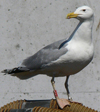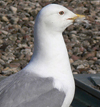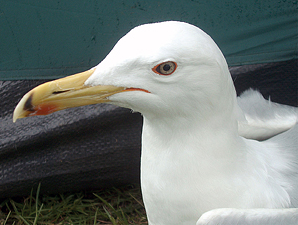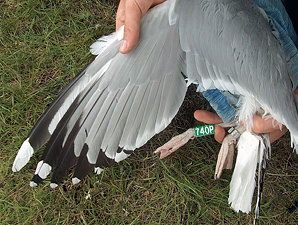 Larus cachinnans
Larus cachinnans
(last update:
Greg Neubauer
Marcin Przymencki
Albert de Jong
Mars Muusse
adult cachinnans: May
The origin of ‘Caspian Gulls’ breeding in Poland
BY: Grzegorz Neubauer and Magdalena Zagalska-Neubauer
IN: British Birds 100-September 2007, 552-557.
The Caspian Gull Larus (argentatus) cachinnans originally inhabited southeast Europe, where it bred on flat, sandy lagoons along the coast and at steppe reservoirs (Yudin & Firsova 1988). The population has increased significantly in the past 100 years, however, which has resulted in range expansion to the north and west, a trend that is still clear in Ukraine, Poland, and Belarus (BirdLife International 2004). As the bird’s range expanded, new breeding sites were established primarily along large rivers in Russia (Volga) and Ukraine (Dnepr, Dnestr); the species arrived in the Moscow area in the 1960s (Jonsson 1998; Panov & Monzikov 1999), whereas in west-central Ukraine it reached the Cherkassy district during the 1970s (A. Poluda pers. comm.) and the first breeding record in Ivano-Frankovsk district was in 1989 (Gorban 1992). During the 1980s, a breeding population was established along the Vistula River, east-central Poland (Tomialojc & Stawarczyk 2003). The Polish breeding population has subsequently increased exponentially, reaching 480 pairs in 2004, and over 500 pairs in 2005 (Skorka et al. 2005; Neubauer et al. 2006; authors’ unpublished data). Skorka et al. (2005) showed that the growth of the colony in Tarnow must have been due largely to immigration, as local production of young was insufficient to explain the colony’s growth.
Between 1999 and 2006, about 500 large white-headed gulls were trapped at inland breeding colonies in central and southern Poland, and three ringing recoveries of Caspian Gull were obtained. All three breeding adults had been ringed as chicks in Ukraine, confirming the eastern origin of Caspian Gulls breeding in Poland (table 1). Almost all the adult Caspian Gulls trapped in Poland are unringed, and there are few individuals of local origin; presumably, most of the former come from eastern, perhaps Ukrainian, colonies. Caspian Gulls are still expanding in middle Dnepr valley area, where new breeding sites are established each year (A. Poluda pers. comm.).
Identification of (unringed) Caspian Gulls in Polish breeding colonies requires caution because hybridisation between Caspian and Herring Gulls L. argentatus argentatus in Poland is frequent (Neubauer et al. 2006), Criteria used by the authors were defined by determining the range of morphological variation of 56 Caspian Gulls trapped at Molochnyy Lyman, Zaporozhye district, southern Ukraine in 2000-01, a population that apparently functions as a source of immigrants (see table 1). The most important characters for Caspian Gulls are as follows: intensive iris pigmentation (medium-dark to dark, only exceptionally weakly spotted dark); slim bill (with bill-shape index - bill length divided by bill depth at gonys – above 3.00); and intense bare part colours (orange to red eye-ring and gape). Also critical is the pattern on the outermost primary: a deep (whitish) tongue on the inner web; subterminal black area, measured along the shaft at less than 42 mm in females and less than 53 mm in males; and pure white feather tip, typically longer than the subterminal black area, 56-73 mm in females and 60-75 mm in males.
| Ring no. | Ringing data | Recovery data | Distance |
| Kiev L 002483 |
Dnepr River, Kanivska GES, Cherkassy district, Ukraine, 49°46’N 31°28’E, pullus, 23rd May 2000 | Wloclawek Reservoir, central Poland, 52°39`N 19°08’E, May 07 2005, female, controlled at nest with eggs | 917.2 km |
| Kiev L 000731 |
Dnepr River, Kanivska GES, Cherkassy district, Ukraine, 49“46`N 31°28’E, pullus, June 08 1998 | Jankowice gravel-pit, near Zator, southern Poland 50°02‘N 19°26’E, April 23 2005, female, controlled at nest with eggs | 863.3 km |
| Moskwa C 513828 |
Island Podkova, Molochnyy Lyman, Zaporozhye district, Ukraine, 46"37’N 35°22’E, pullus, May 24 2000 | Jankowice gravel-pit, near Zator, southern Poland, 50"02’N 19°26’E, May 01 2006, male, controlled at nest with eggs | 1238.4 km |
Table 1. Ringing recoveries of Caspian Gull Larus (argentatus) cachinnans breeding in Poland.
Although the range of variation in Caspian Gulls is probably much wider than these criteria suggest, ongoing hybridisation demands a conservative approach. Trapped individuals which do not meet these criteria are classed as intermediates, although several of these may also be ‘pure’ Caspian Gulls.
Two ringed Caspian Gulls were trapped in a colony at Jankowice, where this species has bred since at least 1999 (Faber et al. 2001; Neubauer et al. 2006); the colony size there remains stable, with c. 120 breeding pairs. The third ringed bird was trapped at Wloclawek Reservoir in 2005, where a colony of some 125-130 pairs have bred since 1999 (the colony was first established in 1985). Many of these are Herring Gulls; Caspian Gulls and mixed pairs (Herring x Caspian) constitute less than half the colony, although the numbers of Caspian Gulls increase each year. The Ukrainian-ringed female was paired with a male Caspian Gull and laid three eggs; two young hatched successfully (on 8th and 9th May) and both were colour-ringed on 25th May, Despite intensive fieldwork, the female was not seen in 2006 or 2007, although its mate in 2005 was seen many times, apparently paired with another female.
Other ringing recoveries show that immigrants from remote parts of the breeding range of Caspian Gull are bolstering central European populations of this species. Natal dispersal distances of 800-1,200 km may not be exceptional and may even prove to be quite normal for this species. This contrasts with the behaviour of the closely related Herring Gull, which shows a high degree of natal philopatry. For example, must birds from the Isle of May were reported breeding within 100 km of their natal colony, with exceptional individuals travelling 400-565 km (Duncan & Monaghan 1977); for the British population as a whole, natal dispersal distance was also small, with just single individuals recovered as far away as Iceland or Spain (Wernham et al. 2002; note that breeding was assumed only by recovery timing and breeding age).
Although Caspian Gull remains an uncommon vagrant in many parts of western Europe, its westernmost breeding populations, in Poland and eastern Germany, are increasing (Klein 2001; Neubauer et al. 2006), Moreover, westerly dispersal of young birds (Malling Olsen & Larsson 2003; Klein & Neubauer 2006) may cause occasional individuals to breed with Herring and Lesser Black-backed Gulls L. fuscus in western Europe, far from the regular breeding range.
References
See PDF
Population growth in Poland for some colonies. List incomplete.
Middle Vistula valley: middle 1980’s: first breeding pairs cachinnans. (Ibis 2005 147, 471–482)
Tarnów: 1992 - 1 pair; 2001 – 177 pairs (95% cachinnans, <5% michahellis). (Ibis 2005 147, 471–482; Waterbirds 2007 30, 624-629)
Tarnów area: 2004 - 9 breeding locations cachinnans. (Ibis 2005 147, 471–482)
Radlów: 1997 - 3-4 pairs cachinnans. (Ibis 2005 147, 471–482)
Bielowy: 2001 – 2-3 pairs cachinnans. (Ibis 2005 147, 471–482)
Jankowice: 1998 – 10 pairs cachinnans. (Waterbirds 2007 30, 624-629)
Jankowice: 2003 – 80 pairs cachinnans. (Ibis 2005 147, 471–482)
Jankowice: 2002 – 100 pairs (95% cachinnans, <5% michahellis). (Waterbirds 2007 30, 624-629)
Jankowice: 2003 – 104 pairs (95% cachinnans, <5% michahellis). (Ornis Fennica 2011 88, 80-89)
Jankowice: 2004 – 119 pairs (95% cachinnans, <5% michahellis). (Ornis Fennica 2011 88, 80-89)
Jankowice: 2006 – 120 pairs (95% cachinnans, <5% michahellis). (British Birds 100 2007, 552–557; Waterbirds 2007 30, 624-629)
Dwory: 2000 – 1 pair cachinnans. (Ibis 2005 147, 471–482)
Palczowice: 2003 - 2 pairs cachinnans. (Ibis 2005 147, 471–482)
Goczalkowice: 2003 – 8 pairs cachinnans. (Ibis 2005 147, 471–482)
Czorsztyn: 2003 – 7 pairs cachinnans. (Ibis 2005 147, 471–482)
Włocławek Reservoir: 1985 – 1 pair cachinnans. (British Birds 100 2007, 552–557)
Włocławek Reservoir: 2005 – 125 pairs (>50% argentatus, <50% cachinnans & hybrids). (British Birds 100 2007, 552–557)
Kozienice: 2003 – 5 pairs cachinnans. (Ornis Fennica 2011 88, 80-89)
Kozienice: 2004 – 3 pairs cachinnans. (Ornis Fennica 2011 88, 80-89)
Zastów Karczmiski: 2004 – 240 pairs (95% cachinnans, <5% argentatus). (Ornis Fennica 2011 88, 80-89)
Zastów Karczmiski: 2012 – 592 pairs (90% cachinnans, <10% hybrid / argentatus). (pers comm. Łukasz Bednarz)
Urszulin Wytyckie Lake: 2012 – 150 pairs cachinnans. (pers comm. Łukasz Bednarz)
Bubnow marshes: 2012 – 2 pairs cachinnans.(pers comm. Łukasz Bednarz)
Wincencin Krasnystaw: 2012 – 2 pairs cachinnans.(pers comm. Łukasz Bednarz)
 Larus cachinnans adult UKK L-002095 May 06 2013, Gatovo - Minsk, Belarus. Picture: Dmitry Goncharov.
Larus cachinnans adult UKK L-002095 May 06 2013, Gatovo - Minsk, Belarus. Picture: Dmitry Goncharov. Larus cachinnans 19+CY male P351 April 25 2006 & May 03 2007, Włocławek Reservoir, central Poland. Picture: Magdalena Zagalska-Neubauer.
Larus cachinnans 19+CY male P351 April 25 2006 & May 03 2007, Włocławek Reservoir, central Poland. Picture: Magdalena Zagalska-Neubauer. Larus cachinnans adult female P402 May 02 2006, Włocławek Reservoir, central Poland. Picture: Magdalena Zagalska-Neubauer.
Larus cachinnans adult female P402 May 02 2006, Włocławek Reservoir, central Poland. Picture: Magdalena Zagalska-Neubauer. Larus cachinnans adult female P488 May 01 2006, Włocławek Reservoir, central Poland. Picture: Magdalena Zagalska-Neubauer.
Larus cachinnans adult female P488 May 01 2006, Włocławek Reservoir, central Poland. Picture: Magdalena Zagalska-Neubauer. Larus cachinnans 437P May 06 2013, Gatovo - Minsk, Belarus. Picture: Dmitry Goncharov.
Larus cachinnans 437P May 06 2013, Gatovo - Minsk, Belarus. Picture: Dmitry Goncharov. Larus cachinnans adult female 702P May 02 2006 & April 28 2007, Włocławek Reservoir, central Poland. Picture: Magdalena Zagalska-Neubauer.
Larus cachinnans adult female 702P May 02 2006 & April 28 2007, Włocławek Reservoir, central Poland. Picture: Magdalena Zagalska-Neubauer. Larus cachinnans adult female 718P April 28 2006, April 28 2007, May 01 2008, April 30 2009, Włocławek Reservoir, central Poland. Picture: Magdalena Zagalska-Neubauer.
Larus cachinnans adult female 718P April 28 2006, April 28 2007, May 01 2008, April 30 2009, Włocławek Reservoir, central Poland. Picture: Magdalena Zagalska-Neubauer. Larus cachinnans 6CY female 740P May 2005, Włocławek Reservoir, central Poland. Picture: Magdalena Zagalska-Neubauer. Hatched in Ukraine 2000.
Larus cachinnans 6CY female 740P May 2005, Włocławek Reservoir, central Poland. Picture: Magdalena Zagalska-Neubauer. Hatched in Ukraine 2000. Larus cachinnans adult male 801P May 03 2006, Włocławek Reservoir, central Poland. Picture: Magdalena Zagalska-Neubauer.
Larus cachinnans adult male 801P May 03 2006, Włocławek Reservoir, central Poland. Picture: Magdalena Zagalska-Neubauer. Larus cachinnans hybrid 8CY male 876P May 2004, Wloclawek Reservoir, Poland. Picture: Magdalena Zagalska-Neubauer.
Larus cachinnans hybrid 8CY male 876P May 2004, Wloclawek Reservoir, Poland. Picture: Magdalena Zagalska-Neubauer. Larus cachinnans adult male 888P April 30 2006 & May 02 2008, Włocławek Reservoir, central Poland. Picture: Magdalena Zagalska-Neubauer.
Larus cachinnans adult male 888P April 30 2006 & May 02 2008, Włocławek Reservoir, central Poland. Picture: Magdalena Zagalska-Neubauer. Larus cachinnans 8CY-9CY male 896P 2006 & 2007, Wörth, Austria & Włocławek Reservoir, Poland. Picture: Wolfgang Schweighofer & Magdalena Zagalska-Neubauer.
Larus cachinnans 8CY-9CY male 896P 2006 & 2007, Wörth, Austria & Włocławek Reservoir, Poland. Picture: Wolfgang Schweighofer & Magdalena Zagalska-Neubauer. Larus cachinnans adult male 897P May 02 2006, Włocławek Reservoir, central Poland. Picture: Magdalena Zagalska-Neubauer.
Larus cachinnans adult male 897P May 02 2006, Włocławek Reservoir, central Poland. Picture: Magdalena Zagalska-Neubauer. Larus cachinnans adult female 00P3 May 01 2007 & May 02 2009, Włocławek Reservoir, central Poland. Picture: Magdalena Zagalska-Neubauer.
Larus cachinnans adult female 00P3 May 01 2007 & May 02 2009, Włocławek Reservoir, central Poland. Picture: Magdalena Zagalska-Neubauer. Larus cachinnans adult male 02P5 May 03 2009, Włocławek Reservoir, central Poland. Picture: Magdalena Zagalska-Neubauer.
Larus cachinnans adult male 02P5 May 03 2009, Włocławek Reservoir, central Poland. Picture: Magdalena Zagalska-Neubauer. Larus cachinnans adult female 03P5 May 03 2009, Włocławek Reservoir, central Poland. Picture: Magdalena Zagalska-Neubauer.
Larus cachinnans adult female 03P5 May 03 2009, Włocławek Reservoir, central Poland. Picture: Magdalena Zagalska-Neubauer. Larus cachinnans adult female 07P1 May 01 2006 & April 29 2009, Włocławek Reservoir, central Poland. Picture: Magdalena Zagalska-Neubauer.
Larus cachinnans adult female 07P1 May 01 2006 & April 29 2009, Włocławek Reservoir, central Poland. Picture: Magdalena Zagalska-Neubauer. Larus cachinnans adult female 15P1 May 03 2006 & April 30 2008, Włocławek Reservoir, central Poland. Picture: Magdalena Zagalska-Neubauer.
Larus cachinnans adult female 15P1 May 03 2006 & April 30 2008, Włocławek Reservoir, central Poland. Picture: Magdalena Zagalska-Neubauer. Larus cachinnans hybrid 6cy 16P2 May 2011, Vistula, near Warsaw, Poland. Picture: Marcin Sidelnik/Michal Rycak.
Larus cachinnans hybrid 6cy 16P2 May 2011, Vistula, near Warsaw, Poland. Picture: Marcin Sidelnik/Michal Rycak. Larus cachinnans 6CY & 10CY female 17P1 May 05 2005 & April 30 2009, Włocławek Reservoir, central Poland. Picture: Magdalena Zagalska-Neubauer.
Larus cachinnans 6CY & 10CY female 17P1 May 05 2005 & April 30 2009, Włocławek Reservoir, central Poland. Picture: Magdalena Zagalska-Neubauer. Larus cachinnans adult female 50P3 May 01 2008, Włocławek Reservoir, central Poland. Picture: Magdalena Zagalska-Neubauer.
Larus cachinnans adult female 50P3 May 01 2008, Włocławek Reservoir, central Poland. Picture: Magdalena Zagalska-Neubauer. Larus cachinnans adult female 51P3 May 02 2008, Włocławek Reservoir, central Poland. Picture: Magdalena Zagalska-Neubauer.
Larus cachinnans adult female 51P3 May 02 2008, Włocławek Reservoir, central Poland. Picture: Magdalena Zagalska-Neubauer. Larus cachinnans adult female 58P4 May 01 2009, Włocławek Reservoir, central Poland. Picture: Magdalena Zagalska-Neubauer.
Larus cachinnans adult female 58P4 May 01 2009, Włocławek Reservoir, central Poland. Picture: Magdalena Zagalska-Neubauer. Larus cachinnans adult female 95P2 May 01 2008, Włocławek Reservoir, central Poland. Picture: Magdalena Zagalska-Neubauer.
Larus cachinnans adult female 95P2 May 01 2008, Włocławek Reservoir, central Poland. Picture: Magdalena Zagalska-Neubauer. Larus cachinnans hybrid 3CY, 5CY & 7CY male 4P46 November 2006 & October 2011, Detmold, Germany & May 2008, Włocławek Reservoir, central Poland.
Larus cachinnans hybrid 3CY, 5CY & 7CY male 4P46 November 2006 & October 2011, Detmold, Germany & May 2008, Włocławek Reservoir, central Poland. Larus argentatus sensu lato P429 adult, 2012-2013, Zastow Karczmiski, Poland & February 2014, Bucharest, Romania. Likely argentatus.
Larus argentatus sensu lato P429 adult, 2012-2013, Zastow Karczmiski, Poland & February 2014, Bucharest, Romania. Likely argentatus. Larus cachinnans 6CY female PCVU May 12 2011, Kozielno - Paczkow, Opolskie Poland. Picture Michal Rycak.
Larus cachinnans 6CY female PCVU May 12 2011, Kozielno - Paczkow, Opolskie Poland. Picture Michal Rycak. Larus argentatus? 7CY KE21 May 04 2012,Gatovo - Minsk district, Belarus. Picture: Dmitry Goncharov.
Larus argentatus? 7CY KE21 May 04 2012,Gatovo - Minsk district, Belarus. Picture: Dmitry Goncharov. Larus cachinnans 1CY, 2CY & 7CY female KE74 2006, 2007 & 2012, Germany, Poland & Belarus. Picture: Jürgen Steudtner, Ruud Altenburg & Dmitry Goncharov.
Larus cachinnans 1CY, 2CY & 7CY female KE74 2006, 2007 & 2012, Germany, Poland & Belarus. Picture: Jürgen Steudtner, Ruud Altenburg & Dmitry Goncharov. Larus cachinnans x argentatus hybrid adult female S.S
Larus cachinnans x argentatus hybrid adult female S.Sand Larus michahellis adult male J.N May 21 2013, Amerongen sluizen complex, The Netherlands. Picture: PieterGeert Gelderblom.
 Caspian Gull cachinnans 9.W 7CY-8CY, April - July 2020-2021, Gatovo - Minsk, Belarus. Picture: Irina Samusenko.
Caspian Gull cachinnans 9.W 7CY-8CY, April - July 2020-2021, Gatovo - Minsk, Belarus. Picture: Irina Samusenko. Larus cachinnans adult, May 06 2013, Gatovo - Minsk, Belarus. Picture: Dmitry Goncharov.
Larus cachinnans adult, May 06 2013, Gatovo - Minsk, Belarus. Picture: Dmitry Goncharov. Larus cachinnans hybrid? adult, May 06 2013, Gatovo - Minsk, Belarus. Picture: Dmitry Goncharov.
Larus cachinnans hybrid? adult, May 06 2013, Gatovo - Minsk, Belarus. Picture: Dmitry Goncharov. Paired with Lesser Black-backed Gull.
 Larus cachinnans hybrid 9CY male, May 2002, Wloclawek Reservoir, Poland. Picture: Magdalena Zagalska-Neubauer.
Larus cachinnans hybrid 9CY male, May 2002, Wloclawek Reservoir, Poland. Picture: Magdalena Zagalska-Neubauer. Larus cachinnans hybrid 9cy female, May 2011, Przykona Reservoir, central Poland. Picture: Thomas Iciek.
Larus cachinnans hybrid 9cy female, May 2011, Przykona Reservoir, central Poland. Picture: Thomas Iciek. Larus cachinnans hybrid 6CY, May 2011, Vistula, near Warsaw, Poland. Picture: Marcin Sidelnik/Michal Rycak.
Larus cachinnans hybrid 6CY, May 2011, Vistula, near Warsaw, Poland. Picture: Marcin Sidelnik/Michal Rycak. Larus cachinnans adult, May 30 2011, Aktogay, East-Kazakhstan Province (46,57N 79,40E). Picture: Gabor Papp.
Larus cachinnans adult, May 30 2011, Aktogay, East-Kazakhstan Province (46,57N 79,40E). Picture: Gabor Papp. Black on P3-P10; P1-P10 old.
 Larus cachinnans adult, May 30 2011, Aktogay, East-Kazakhstan Province (46,57N 79,40E). Picture: Gabor Papp.
Larus cachinnans adult, May 30 2011, Aktogay, East-Kazakhstan Province (46,57N 79,40E). Picture: Gabor Papp. Full subterminal band on P10; small mirror on P9.
 Larus cachinnans adult, May 30 2011, Aktogay, East-Kazakhstan Province (46,57N 79,40E). Picture: Gabor Papp.
Larus cachinnans adult, May 30 2011, Aktogay, East-Kazakhstan Province (46,57N 79,40E). Picture: Gabor Papp. P1 missing, P2-P10 old.
 Larus cachinnans adult, May 30 2011, Aktogay, East-Kazakhstan Province (46,57N 79,40E). Picture: Gabor Papp.
Larus cachinnans adult, May 30 2011, Aktogay, East-Kazakhstan Province (46,57N 79,40E). Picture: Gabor Papp.  Larus cachinnans adult, May 30 2011, Aktogay, East-Kazakhstan Province (46,57N 79,40E). Picture: Gabor Papp.
Larus cachinnans adult, May 30 2011, Aktogay, East-Kazakhstan Province (46,57N 79,40E). Picture: Gabor Papp. Larus cachinnans adult, May 30 2011, Aktogay, East-Kazakhstan Province (46,57N 79,40E). Picture: Gabor Papp.
Larus cachinnans adult, May 30 2011, Aktogay, East-Kazakhstan Province (46,57N 79,40E). Picture: Gabor Papp.
